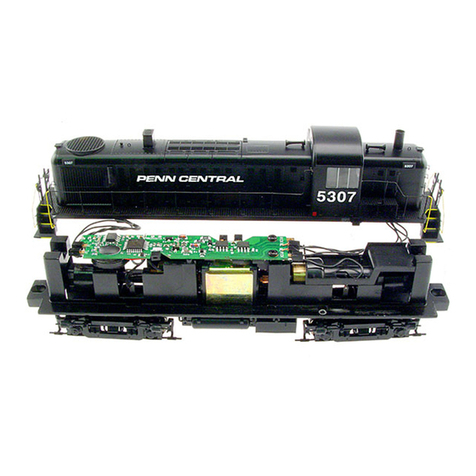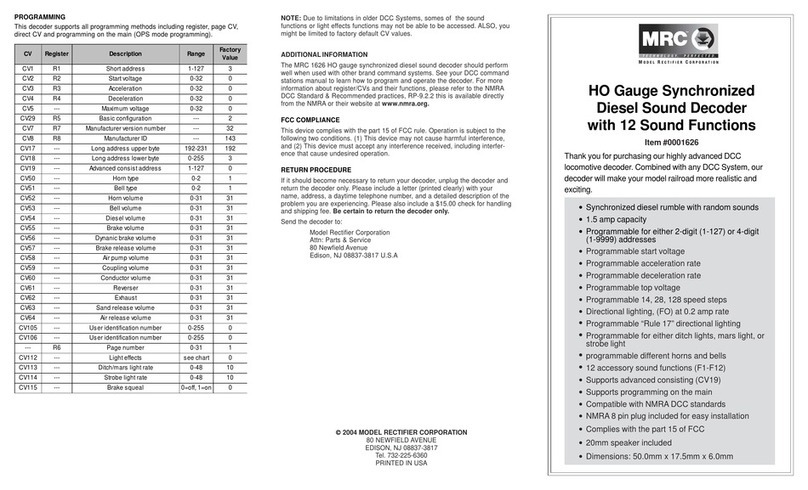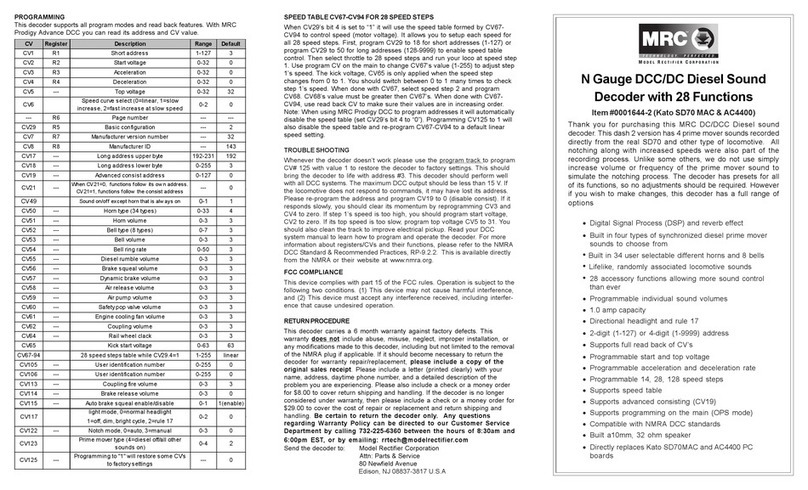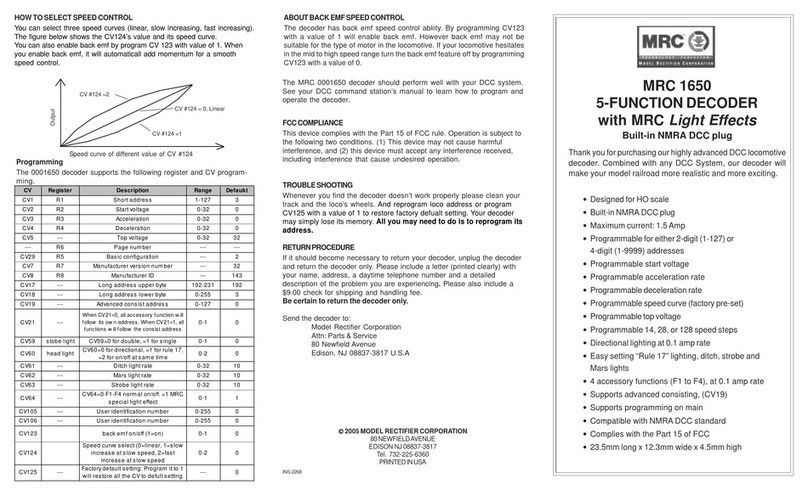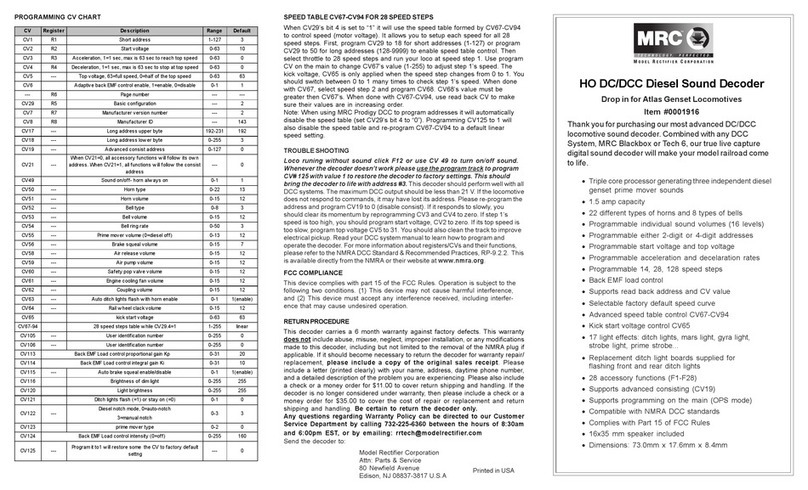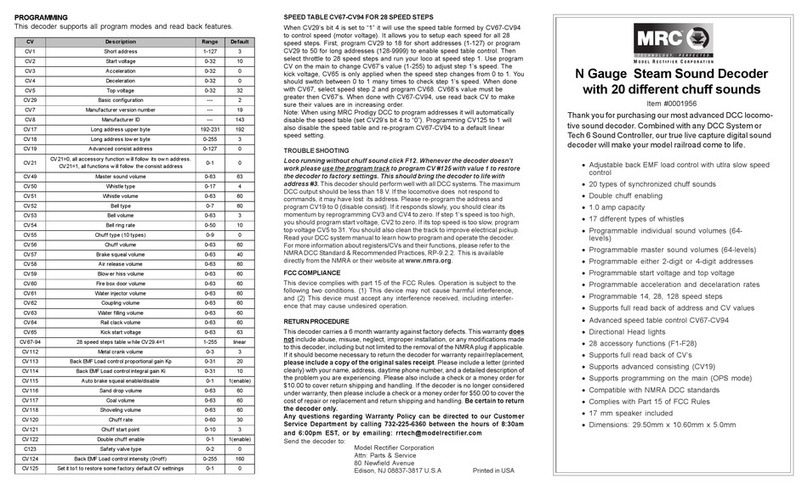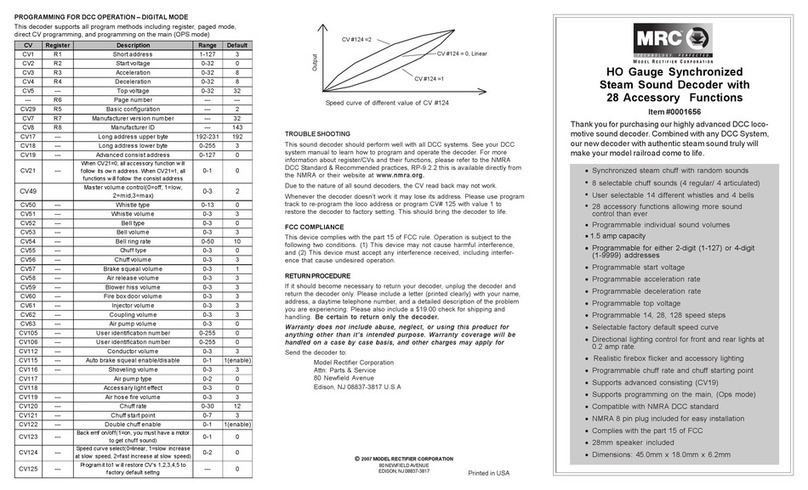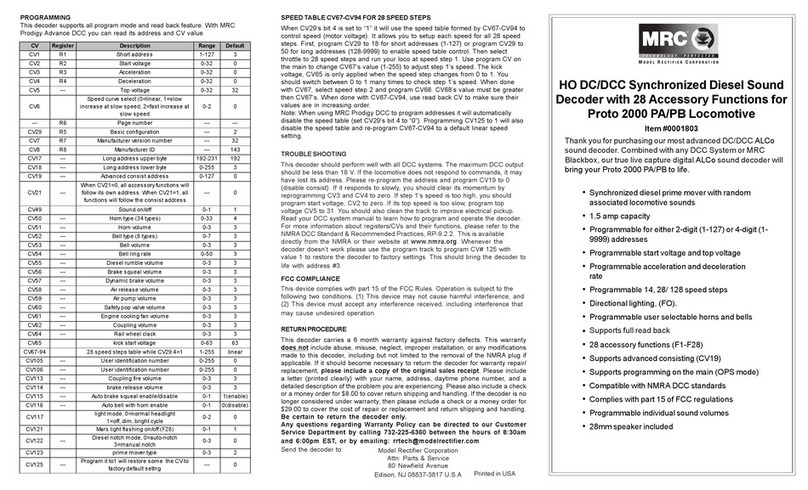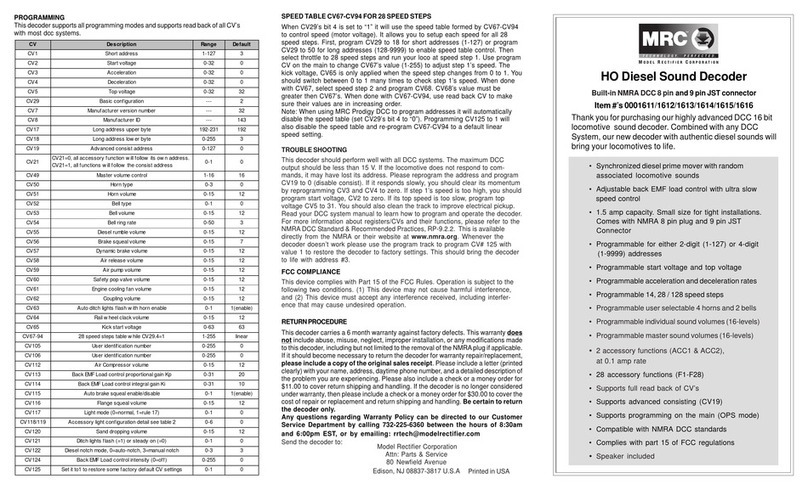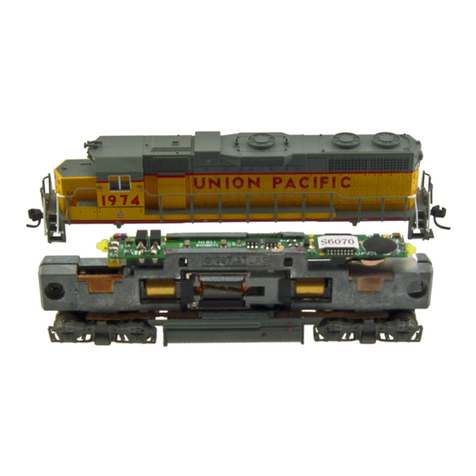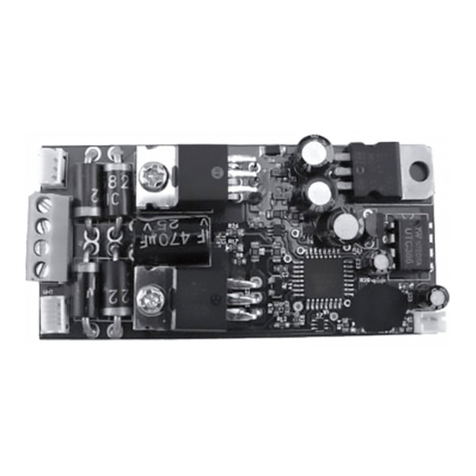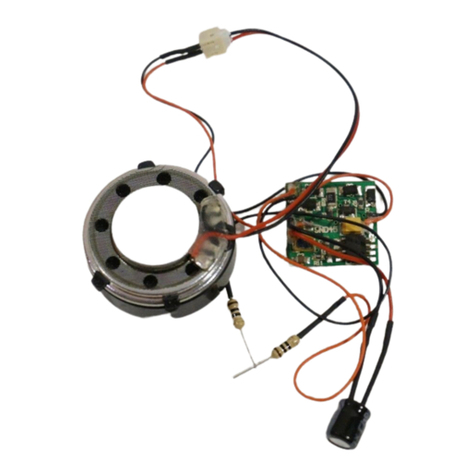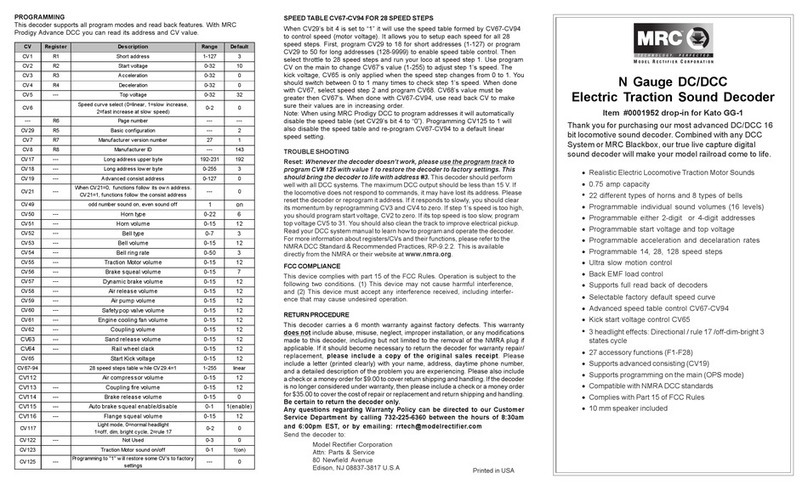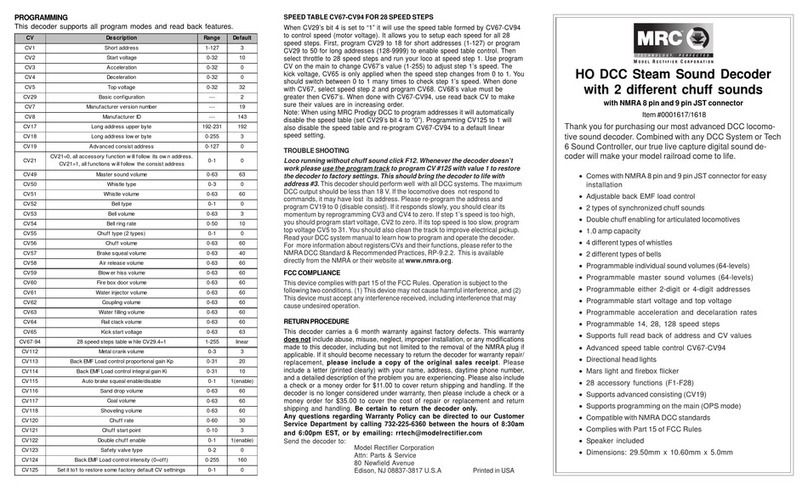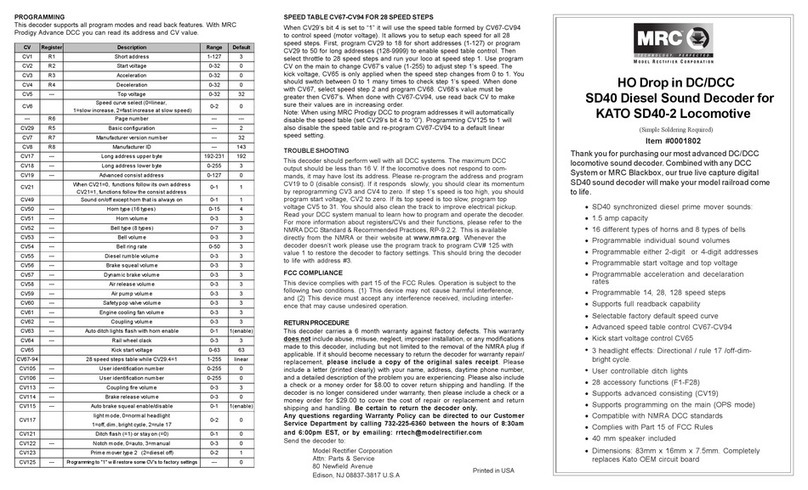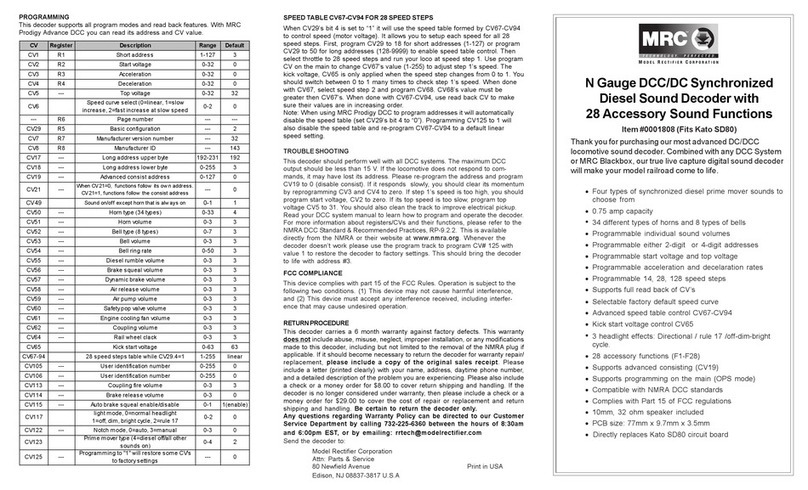
Function Idle/Moving
F1 Bell on/off
F2 Horn
F3 air release
F4 Coupling 1
F5 Brake release (idle) / brake squeal (moving)
F6 Dynamic brake on/off
F7 Air hose firing/uncoupling lever
F8 3 times will shut down when in idle / Manual notch down
F9 Engine cooling fan / Manual notch up
F10 Rail wheel clack (onlymoving)
F11 Traction air compressor
F12 Change prime diesel mover type (CV123, 6 types)
F13 Master volume reduce by1 / air release when reach minimal
F14 Master volume increase by 1/ air release when reach maximal
F15 Air com pres s or
F16 Flange squeal
F17 Air release
F18 Change bell type (8 types plus off)
F19 Horn type select (total 22 different horns plus off)
F20 Associated loco sound
F21 Change bell volume and turn on the bell
F22 Change horn volume
F23 Change diesel rumble volume
F24 Safe ty val ve pop
F25 Air release
F26 Flange noise
F27 Sand drop
F28 Air release
INSTALLATION
Your new Sound Decoder will virtually “drop-in” to a Kato SD45, Kato SD70MAC
and AC4400 diesel locomotive. It may fit in many other N scale locomotives with
slight modification. Although easy, please follow instructions carefully.
The most important step in the installation is to insulate the motor
terminals from the wheel pickups. Fail to do so will damage the decoder.
Remove the locomotive body following Kato’s instructions. Remove the original
circuit board by very carefully sliding the circuit board slightly to the rear of the
chassis. Lift out. The decoder is installed in the same location.
First, deburr the chassis (with emery cloth) any casting flash that may cause a
sharp edge under the location of the insulation tape. Then, using electrical or
equiv plastic tape, carefully tape the chassis in the areas as indicated in Fig 1 to
isolate the decoder from the chassis. This must be done to prevent damage to the
decoder. Align the decoder and carefully insert it in the slots in the chassis. Gently
press down on the rear (speaker side) of the decoder while sliding it into position,
being careful not to bend the PC board and the vertical copper motor contacts on
the side of the chassis. Ensure the vertical copper contacts (on the decoder)
cover the thin vertical motor contacts. The motor contacts must not touch the loco
chassis. The decoder installation is complete.
When replacing the body, ensure the copper contacts on the trucks are under the
horizontal chassis contacts.
Fig 1
Note: Since the decoder fits different locomotive models, you may need to
extend the light tube lenses, or L.E.D. legs for optimum lighting.
CAUTION:
The decoder must be isolated as shown. Apply electrical tape or kapton tape in
the areas shown to prevent the electrical contacts from touching the chassis and
damaging the decoder.
DCC OPERATION
The decoders have been factory programmed with address #3, 28/128 speed
steps and maximum top voltage. Select the “Run” mode of your DCC system and
select or acquire address #3. Move up the throttle and the loco should move.
The decoder has 6 types of diesel prime mover sounds. You can use F12 to
change different type of diesel motor. You can also program CV123 to value of 0
to 5 to select the correct prime mover for your diesel locomotive. The CV123
table shows the 6 prime movers and examples of the locomotive types that use
them.
The decoder has start up and shut down feature. If the loco is previously shut
down you have to start up the engine you have to press any function key to start
up the engine before operating the loco. To shut down the engine you must bring
the loco to idle and then press F8 three times.
The decoder has 22 different horns. You can use F19 or program CV50 to select
these horns. You can also use F18 or program CV52 to select the different 8 bell
sounds.
Most of the sounds have their own volume control CV. There is also a master
sound volume control, CV49. Press F13 will reduce the master volume by 1 (you
will hear a air release when you reach CV49=1). Press F14 will increase volume
by 1 (you will hear a air release when you reach CV49=16). Program CV49 to 0
will turn the sound off.
The decoder is default to automatic notching. You can program CV122 to 3 to set
manual notching for realistic operation. Then use F9 to notch up and use F8 to notch
down. In real life the notch level, (engine R.P.M.’s) has no bearing on actual
locomotive track speed. This is determine by throttle setting and tonnage.
To achieve slow speed at speed step one, you have to program start voltage CV2 and
kick start voltage CV65. The kick start voltage will only kick in for a very short period
of time when speed command changes from 0 to 1.
There are many program features available with this decoder. Please refer to the CV
Chart to explore other features of the decoder.
Note: Bell, Dynamic Brake and Rail Wheel Clack cannot play at the same time. If you
activate the Bell sound [F1], while either the Dynamic Brake or Rail Wheel Clack
sounds are activated, the Bell sound will override the other 2 sounds. Rail Wheel
Clack cannot play while the loco is in idle. When you turn off the Dynamic Brake and
Rail Wheel Clack sound there will be one second delay.
Chassis Slots
Tape here
Tape must extend down the sides as shown
Chassis Slots
Truck/Chassis contact
These Vertical copper contacts (motor terminals)
can not touch the chassis (wheel pickups)
vertical motor contact
(must be positioned as shown)
CV123 Prime mover
SD39, SD40, SD40A, SD40-2, SD40T-2, SD45. SDP45, SD45X, SD45-2,
SD45T-2, F45, FP45, DDA40X, GP15T, GP39, GP39-2, GP40, GP40-2
SW1000, SW1001, SW1500, SW1504, MP15DC, MP15AC, MP15T,
GP38, GP38-2, SD38, SD38-2, GP15AC, GP15-1
2 EMD710 SD70AC, SD70M-2
3 ALCO 244
4 ALCO 539T
F2A/B, F3A/B, F7A/B, F9A/B, BL1, BL2, FP7, FL9, FT, GP7, GP9, GP18,
GP28, E6, E7, E8, E9, NW2, NW3, NW4, SW1, SW7, SW8, SW9, SW600,
SW900, SW1200
5 EMD567
0 EMD645E
1 EMD645
Suitable for the locomotive
RS-3, PA1, PB1
S-2, S-4, RS-1, RSC-1, RSD-1, DL-105, DL107, DL-108, DL-109, DL-110













